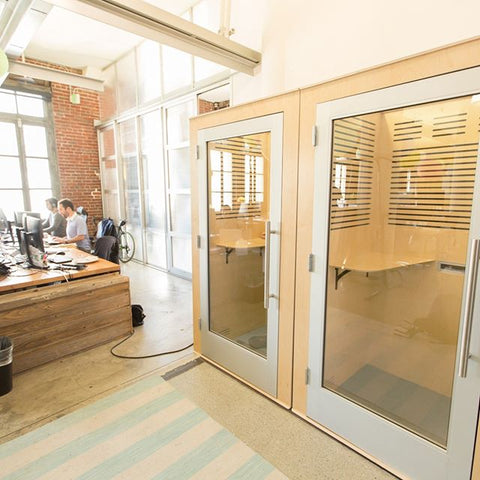Trendy office design does not always translate into elite results. One egregious modern example lies in the “bullpen” style open office concepts that swept American workspaces two decades ago.
Buoyed by the seemingly advanced techniques of technology companies in California and elsewhere, many businesses convinced themselves that the open office represented a futuristic way of thinking and progressive organizational style.
It did not hurt that open office plans cost less money to construct and maintain.
Some advocates insist that open offices provide the best possible space for collective effort and that young workers prefer it. Others argue that the open office style blocks concentration, reduces productivity, and even harms workers’ mental and physical health.
Visual Distractions Hurt Concentration . . .
Nearly three out of every four American offices have low or no partitions separating employee work areas. Almost one-third rate visual distractions as a real problem that interferes with intensive style tasks.

Visual distractions can happen anywhere, even in an enclosed office. Employees in private spaces, however, have the ability to control their environment and reduce the likelihood of interruption.
Open offices, especially those without any partitions, leave employees with no ability to control their environment and prevent distraction. Any flutter of activity can ruin a person’s concentration.
While you can possibly avoid noise pollution by using headphones (unless music also serves as a distraction) you cannot escape visual distraction short of covering your head with a blanket.
This serves as a real productivity problem. Humboldt University in Berlin conducted a study on concentration and found that once deep focus gets broken, it does not get restored for an average of 23 minutes.
If lost concentration means lost productivity, the entire company misses out.
Noise Distractions Harm Health
Noise distractions cause the same loss of concentration as visual distractions, but they can create deeper problems in many in open offices.
According to a study published by the National Center for Biotechnology Information, prolonged exposure to noise causes stimulation of the hypothalamic-pituitary-adrenal-axis.
This causes the release of stress hormones that over time can contribute to serious medical conditions. These include:
-
Immuno-suppression
-
Diabetes
-
Cardiovascular disease
-
Ulcers, and more
One hormone released during prolonged noise is epinephrine, involved in producing the “fight or flight” response. Those who already suffer from anxiety disorders often find themselves experiencing increased discomfort, worry, and stress. These symptoms can lead to physical exhaustion as well.
A different study from the Journal of Applied Psychology indicated that those exposed to noise levels similar to an open office environment lost the ability to solve problems at the same level as they could in quiet environments.
Even more than visual distractions, noise can cause significant issues with both concentration and long-term health.
Increased Sick Days
People working in open office plans do not just have a higher chance of long-term physical and mental health problems. Putting large numbers of people into an enclosed space also creates an environment ripe for spreading contagious viruses and bacterial infections.
Some studies indicate that employees in open offices take up to 62 percent more sick days on average than their counterparts in traditional style workplaces.
When considering the detrimental physical and mental effects of the open office plan, the increase in both sick days taken and demands upon health insurance come as no surprise.
Loss of Office Productivity
Experts have devised a research-based measure dubbed the “productivity tax” to determine the toll taken on businesses in an open office. The measure quantified several problems often faced in the open office, including that:
-
Workers lose an average of 86 minutes per day to distraction, according to a study by Ipsos and the Workspace Futures Team of Steelcase
-
Employee well-being reduction was estimated at 32 percent
-
This leads to the determination that an open office leads to a 15 percent productivity tax
Businesses should take this tax into account when looking at the money saved by adopting the open office. In high priced markets, the loss of productivity may fall below the cost savings in space versus traditional offices. Lower priced markets, however, may make it worthwhile for a company owner to keep individual offices.
A third option lies in the installation of portable office space within established open offices. This keeps the costs savings of the open office while ensuring that employees do have space to escape and work

The Highest Performing Employees Will Suffer from Open Plan Office Anxiety
High performing employees form the core of any operation. They devote themselves entirely to the success of the company, doing any job necessary, covering for others, and forming the foundation of a company’s growth. In workplace jargon, they even get their own shortened reference, HPE.
Enterprise software strategist and productivity expert William Belk explained his open office plan concerns last year in a CNBC article. According to his own survey-based research, open offices dangerously drain productivity from HPEs.
Open Plan Office Anxiety Will Deeply Affect Introverts
Research shows that the brain of an introvert works radically differently than an extrovert. As one example, extrovert brains use dopamine differently than those of introverts.
Extroverts get a physical “rush” from interactions with a variety of people while introvert brains release more of the compound acetylcholine. This substance affects the nervous system in that it calms reactions while provoking deeper thought.
The open office plan intentionally promotes a level of interaction that often (but not always) stimulates extroverts, yet can paralyze introverts. Because nearly half of adult Americans tend toward being introverted, an open office with no private space can push away a great deal of talent.
People Too Focused on “Appearing Busy”
Most open office plans, even ones with one or two separate rooms built in, promote the “fishbowl” effect.
All eyes are on everyone else at all times. Such an environment can grow extremely competitive in that no one wants to look like they're not working. Deep thought and consideration to the untrained eye look like the exact opposite of busy.
When people focus too much on appearances, especially looking busy, they lose focus on the importance of time taken in quiet contemplation necessary for in-depth work projects.
Lack of Privacy Causes Problems Both Professionally and Personally
Lack of privacy serves as one of the biggest non-health related complaints with open offices. For both professional and personal reasons, individuals need private space for communication.
Offices need space for confidential work calls. Some individual or conference calls involve high-level business strategy or tactics that not everyone in the office needs to know about. Other calls involve people or issues covered under stringent federal privacy act laws.
Private conference areas for interviews, disciplinary actions, and work discussions are necessary to prevent interruption and control potential leaks of important information.

How to Solve Your Open Office Anxiety Issues
Most businesses that have tried the open office concept and found it problematic cannot afford to go back to traditional office centered environments.
Zenbooth provides office phone booth furniture that adds to function, complements the office aesthetic, and comes at a reasonable cost. The Comfort Booth for individual use and the Executive Booth for up to two employees both offer much needed private space within an open office.
Reach out to Zenbooth today to find out more about our office privacy solutions. including great deals on multiple purchases.